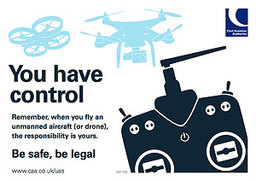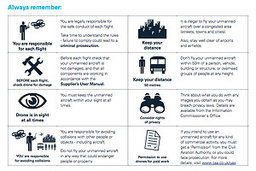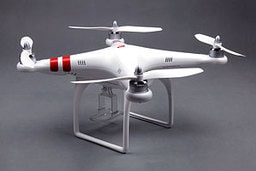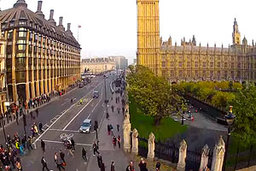I think it’s fair to say that almost everyone has heard of “drones” these days. Whether people think of the military versions used for dropping ordnance on enemy positions, or the seemingly harmless quadcopters that are becoming more and more affordable and can be flown by anyone without any prior training – drones are here to stay.
Having seen how multi-rotor drones evolved from crazy homemade contraptions in people’s garden sheds to the global phenomena they are today, it’s great that this technology has now fallen into the hands of the general public, as opposed to being restricted to those who know how to design and build their own drone from scratch. However, this new concept of ready-to-fly drones has brought its own problems.
From the CAA’s “You have control” leaflet
When I first learned how to fly model aircraft back in 1998, they were so difficult to fly that almost the only route for learning (unless you had deep pockets!) was to take your new model to your local model flying club and learn how to maintain it, repair it and fly it under the instruction of an experienced model aircraft pilot. You would learn about good ground routines, how to correctly set up and test-fly a new model, the dangers of propellers, how radio-control systems are never 100% reliable (that you should always expect live motors and propellers to suddenly start spinning without warning), where you are and aren’t allowed to fly, and most importantly, how to fly your model safely.
Fast forward 16 years and you can now buy a fully-assembled ready-to-fly quadcopter from your local camera shop (or press a button on a webpage and have one appear on your doorstep the next morning), charge the battery, plug it in and be airborne in a matter of minutes. The latest platforms use advanced GPS-assisted flight controllers which make them very easy to fly and mean you do not need any prior tuition to know how to fly them. However, this rapid shortening/elimination of the learning curve means that most new drone pilots these days have not received any of the essential guidance they would have received had they learned to fly at a model flying club.
From the CAA’s “You have control” leaflet
Is it any wonder then that the internet has become littered with videos of people doing reckless things with their drones, putting other people and their property at risk for the sake of capturing some cool aerial video footage? Unfortunately, due to the remote-controlled nature of drones, it is not always easy to find the drones’ operators and advise them of the legal regulations they have to abide by when flying their drone.
The UK Civil Aviation Authority (CAA) and other governing bodies like the British Model Flying Association (BMFA) are understandably very concerned about these recent developments – particularly the way most drones don’t ship with detailed (or any) information about where you can and cannot legally fly them. Fortunately, these bodies, and the drone industry as a whole, are slowly taking steps to enforce the laws of the air and bring justice to those who break them – whether they realise they are breaking the law or not. There are numerous examples of drone operators getting arrested for flying their drones irresponsibly – just do a Google search for “drone pilot arrested” and you will see that the chances of getting arrested if you are caught flying irresponsibly are very real.
From the CAA’s “You have control” leaflet
In response to the rapid rise in popularity of drones, bodies like the CAA and BMFA have also released guidance for how to operate drones safely and within the law.
The CAA has recently written a 2-page leaflet called “You have control” which lists things you should think about before flying your drone: “You have control” leaflet from the CAA. For more detailed information and if you plan to undertake any commercial work with drones, please see this page of their website: Unmanned Aircraft and Aircraft Systems or this blog post.
The BMFA have also written a page of guidelines which you can access here: BMFA Guidance on flying multi-rotor model aircraft. Whilst their guidance focuses on multi-rotor helicopters, it of course applies to any model aircraft.
I have recently starting speaking to resellers of drones like CVP, asking that they include relevant advice about how to operate drones safely alongside their product descriptions: DJI Inspire 1 from CVP. I have also spoken directly to drone operators I have met in public who have been flying irresponsibly (over crowds of people and in built-up areas), asking that they think about the risks posed by the platforms they are flying before they fly again.
At the end of the day, if people continue to fly drones irresponsibly, the UK governing bodies might simply put an outright ban on the use of drones in civilian airspace – like they did in Spain earlier this year. As I see it, it’s the responsibility of every drone pilot to fly legally and considerately, the responsibility of every drone reseller to educate their customers on how to operate their drones safely and the responsibility of drone service providers such as myself to educate the public through whatever channels are available on how to operate drones safely.
Please share this blog post with everyone you know who flies, or is interested in drones, and help keep our skies safe and our drone industry alive! Here is a direct link to this post.
The auditorium at the Christian Science Church in Godalming, Surrey. Click to enlarge.
Click on the image above to read the British Model Flying Association’s guidance for safely operating a multi-rotor drone.
The diminutive DJI Phantom drone has become the most popular off-the-shelf drone, due to its ease of use and compatibility with GoPro cameras, but it is also the platform that has caused the most controversies.
A screenshot from a video on YouTube. Cool? Definitely! Legal? Not by any stretch of the imagination! Risks to the public from distraction-related car accidents, the drone malfunctioning and landing on someone? The consequences don’t really bear thinking about.
Another screenshot from a video on YouTube, and also featured on the BBC News website. Again, the risk to members of the public from even a small drone weighing a kilogram should not be underestimated.






